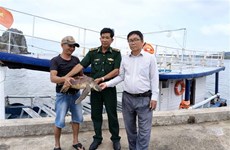Long-term strategy crucial for saving primates
Located in a region dominated by a tropical monsoon climate, Vietnam
is home to some of the world’s rarest wildlife species, including 26
primate species and sub-species, which play a crucial role in cultural
life and scientific research.
Located in a region dominated by a tropical monsoon climate, Vietnam
is home to some of the world’s rarest wildlife species, including 26
primate species and sub-species, which play a crucial role in cultural
life and scientific research.
However, key primate species, such as the Tonkin snub-nosed monkey in northern Ha Giang and Tuyen Quang provinces, and the white-headed langur on Cat Ba island in Hai Phong city, are facing extinction due to poaching, trafficking and habitat loss.
A lack of food and genetic problems triggered by human encroachment into their natural habitats, including the transmission of human diseases, are also partly responsible for reducing the species’ reproductive abilities and survival chances.
Therefore, the development of a long-term strategy and legal framework is urgently needed to protect the primates and allow their populations to recover.
It is also necessary to set up animal rescue centres and conservation sites, as well as investing more in scientific research and increasing public awareness of the need to protect wildlife and the environment.
At the same time, it is advisable to develop sustainable ecological and community-based tourism models and allocate sufficient financial sources for the conservation of these species.
Vietnamese scientists discovered two new primate species, the gray-shanked douc langur and the northern buffed cheeked gibbon, as recent as 2007 and 2010.
The country has established a system of protected areas and special-use forests, spanning 2.2 million ha in 30 national parks and 114 nature reserves.
Established in 1993, the endangered primate rescue centre based in Cuc Phuong National Park , Ninh Binh province, has rescued over 260 individuals, successfully bred 240 offspring and released more than 50 primates back into the wild.
Similar centres are run in Ho Chi Minh City’s outlying district Cu Chi and at Cat Tien National Park in southern Dong Nai province.-VNA
However, key primate species, such as the Tonkin snub-nosed monkey in northern Ha Giang and Tuyen Quang provinces, and the white-headed langur on Cat Ba island in Hai Phong city, are facing extinction due to poaching, trafficking and habitat loss.
A lack of food and genetic problems triggered by human encroachment into their natural habitats, including the transmission of human diseases, are also partly responsible for reducing the species’ reproductive abilities and survival chances.
Therefore, the development of a long-term strategy and legal framework is urgently needed to protect the primates and allow their populations to recover.
It is also necessary to set up animal rescue centres and conservation sites, as well as investing more in scientific research and increasing public awareness of the need to protect wildlife and the environment.
At the same time, it is advisable to develop sustainable ecological and community-based tourism models and allocate sufficient financial sources for the conservation of these species.
Vietnamese scientists discovered two new primate species, the gray-shanked douc langur and the northern buffed cheeked gibbon, as recent as 2007 and 2010.
The country has established a system of protected areas and special-use forests, spanning 2.2 million ha in 30 national parks and 114 nature reserves.
Established in 1993, the endangered primate rescue centre based in Cuc Phuong National Park , Ninh Binh province, has rescued over 260 individuals, successfully bred 240 offspring and released more than 50 primates back into the wild.
Similar centres are run in Ho Chi Minh City’s outlying district Cu Chi and at Cat Tien National Park in southern Dong Nai province.-VNA













